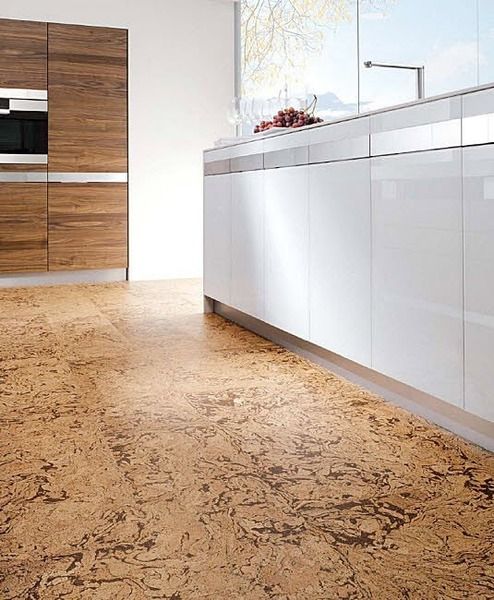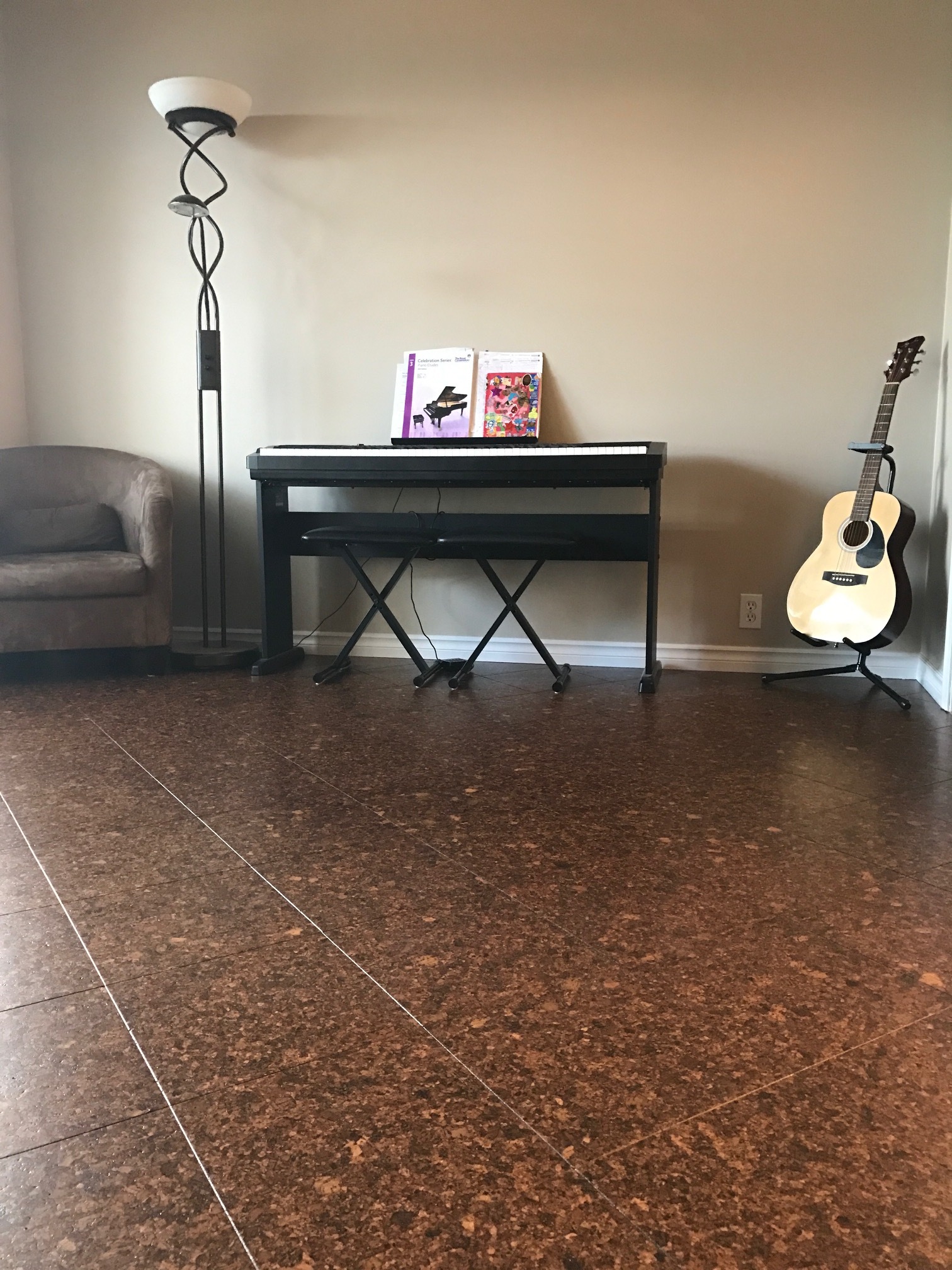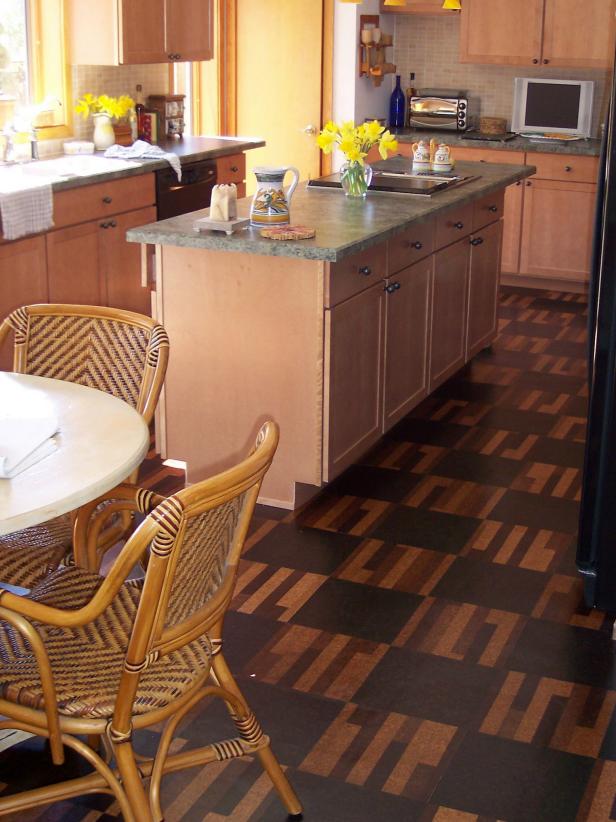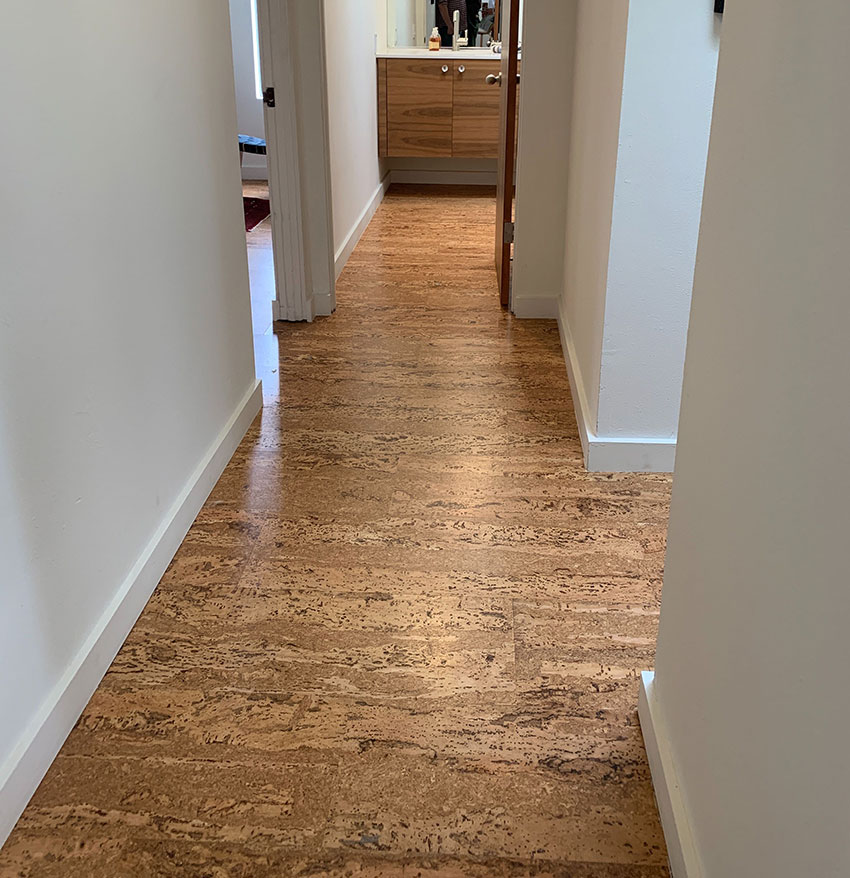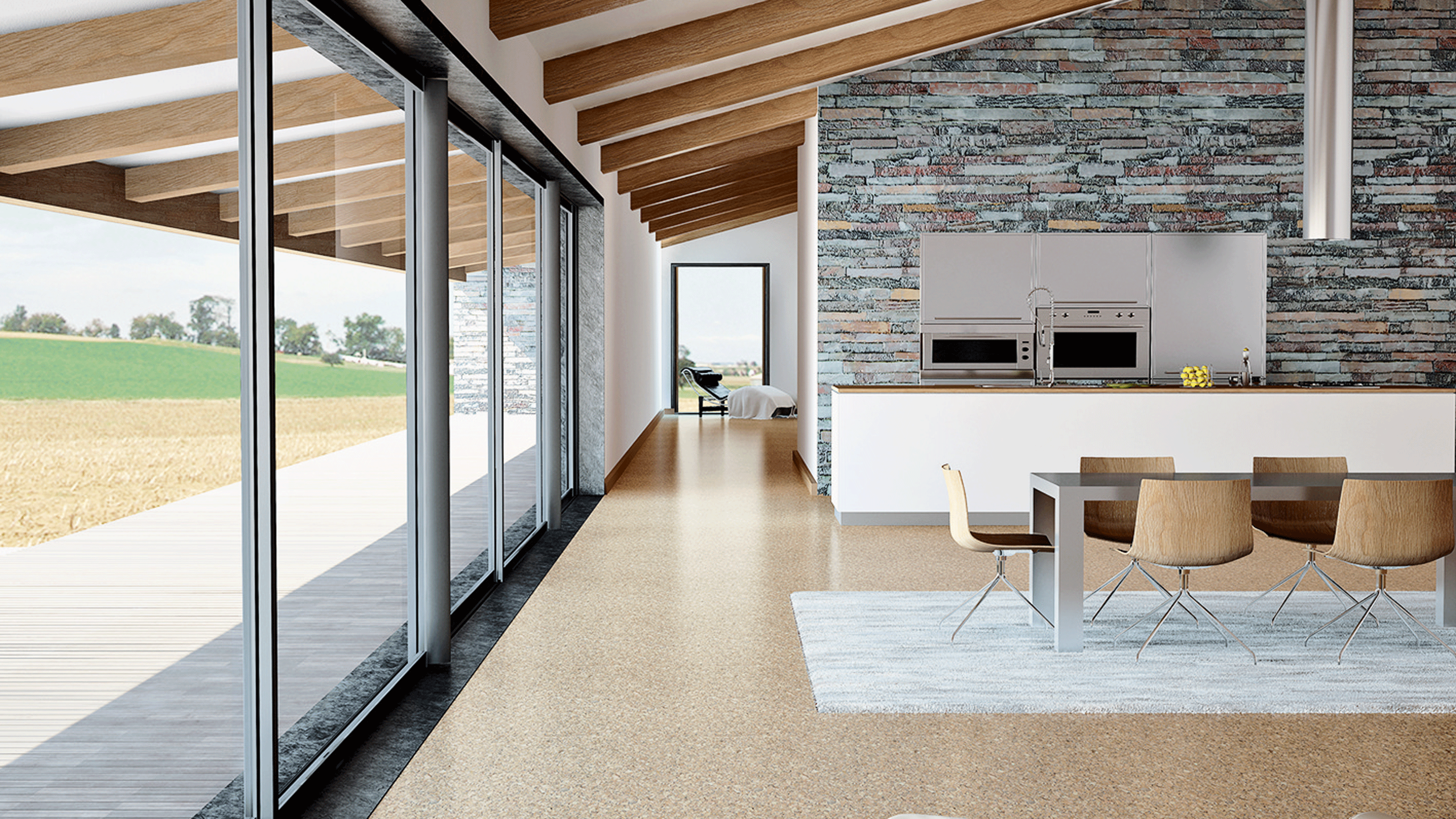Benefits of Cork Flooring: Comfort and Durability
Cork flooring is renowned for its unique combination of comfort and durability. If you’re looking for a flooring option that feels great underfoot and stands up to the demands of daily life, cork might be the perfect choice. Let’s discuss the main benefits of cork flooring that make it both comfortable and durable.
- Natural Comfort: Cork flooring is incredibly comfortable to walk on, thanks to its natural elasticity. The cellular structure of cork contains millions of tiny air pockets, which give it a soft, cushiony feel. This makes cork flooring a pleasure to walk on, reducing the strain on your feet, legs, and back. Whether you’re standing for long periods in the kitchen or playing with your kids in the living room, cork flooring provides a comfortable surface.
- Warmth Underfoot: One of the standout features of cork flooring is its ability to stay warm underfoot. Unlike tile or stone, cork doesn’t conduct heat away from your body, making it a naturally warm flooring option. This is particularly beneficial in colder climates or rooms where you want to maintain a cozy atmosphere. The insulating properties of cork help keep your home warm in the winter and cool in the summer, contributing to overall energy efficiency.
- Noise Reduction: Cork flooring’s sound-absorbing properties make it an excellent choice for reducing noise in your home. The same air-filled cells that provide comfort also help dampen sound, minimizing noise transmission between floors. This makes cork an ideal flooring option for multi-story homes, apartments, or any space where you want to reduce noise levels.
- Durability and Resilience: Despite its soft feel, cork flooring is surprisingly durable. The natural elasticity of cork allows it to recover from minor impacts and dents, making it resistant to everyday wear and tear. This resilience makes cork an excellent choice for high-traffic areas like hallways, kitchens, and living rooms. With proper care, cork flooring can maintain its beauty and functionality for decades.
- Resistance to Mold and Mildew: Cork contains a natural substance called suberin, which makes it resistant to mold, mildew, and pests. This makes cork flooring a healthy choice for your home, as it helps maintain indoor air quality and reduces the risk of allergens. The anti-microbial properties of cork are particularly beneficial in moisture-prone areas like bathrooms and basements.
- Easy Maintenance: Caring for cork flooring is relatively easy. Regular sweeping or vacuuming to remove dirt and debris, along with occasional damp mopping with a mild cleaner, is usually all that’s needed to keep cork floors looking their best. Additionally, cork flooring can be refinished if it starts to show signs of wear, restoring its original beauty without the need for a complete replacement.

Choosing the Right Cork Flooring: Colors and Textures
Selecting the right cork flooring involves considering various factors, including colors and textures. Cork flooring comes in a wide range of styles, allowing you to find the perfect match for your home’s aesthetic. Here’s a guide to help you choose the right cork flooring based on colors and textures.
Natural Colors
Cork flooring is available in its natural color, which ranges from light honey to deep amber. These warm, earthy tones can add a cozy and inviting feel to any room. Natural cork’s subtle variations in color and grain pattern create a unique and organic look that complements various interior design styles, from rustic to contemporary.
Stained and Dyed Cork
If you’re looking for something beyond the natural shades, cork flooring can be stained or dyed in a wide array of colors. From rich browns and deep reds to bold blues and greens, there are plenty of options to suit your design preferences. Stained cork can mimic the appearance of other materials, such as hardwood while retaining its unique benefits.
Printed Cork
Printed cork flooring offers even more design possibilities. Advanced printing technology allows manufacturers to create cork tiles with patterns that resemble wood, stone, or even abstract designs. This option is perfect if you want the look of a different material but with the comfort and sustainability of cork.
Textured Finishes
Cork flooring comes in various textures, adding another dimension to your design. Smooth finishes provide a sleek and modern look, ideal for contemporary spaces. Textured finishes, on the other hand, can add depth and interest to the floor. For example, cork tiles with a hand-scraped or embossed texture can create a rustic or vintage appearance.
Tile and Plank Formats
Cork flooring is available in both tile and plank formats, giving you flexibility in your design. Tiles can be arranged in various patterns, such as checkerboard or herringbone, to create a custom look. Planks, resembling traditional hardwood flooring, can be installed in straight or diagonal patterns, offering a more continuous and streamlined appearance.
Glossy vs. Matte Finish
The finish of your cork flooring can also impact the overall look and feel of the room. Glossy finishes reflect more light, making the floor appear brighter and more polished. They are a good choice for modern or formal settings. Matte finishes, on the other hand, offer a more subdued and natural appearance, ideal for casual or rustic interiors.
Incorporating Cork Flooring into Different Room Designs
Cork flooring is a versatile choice that can enhance the design of various rooms in your home. Its unique properties make it suitable for different spaces, each with its design considerations. Here’s how you can incorporate cork flooring into different room designs effectively.
Living Room
In the living room, cork flooring can create a warm and inviting atmosphere. Opt for natural or stained cork in earthy tones to complement cozy, comfortable furnishings. Cork’s sound-absorbing properties are particularly beneficial in living rooms, reducing noise and creating a quieter, more peaceful environment. Pair cork flooring with area rugs to add texture and define different areas within the room.
Kitchen
Cork flooring is an excellent choice for kitchens due to its resilience and comfort underfoot. Choose a durable finish to withstand spills and high traffic. The cushioning effect of cork makes it easier on your feet and back, which is especially helpful during long cooking sessions. Consider using lighter colors to brighten up the space or opt for a more dramatic, stained cork to make a bold statement.
Bedroom
In bedrooms, cork flooring can enhance the feeling of warmth and relaxation. Its natural insulating properties help maintain a comfortable temperature year-round. Soft, neutral tones can create a calming environment, while printed or textured cork can add a touch of luxury. Cork’s hypoallergenic properties also contribute to a healthier sleeping environment by resisting mold and mildew.
Bathroom
Cork flooring in the bathroom may seem unconventional, but with proper sealing, it can be an excellent choice. Cork’s resistance to moisture and its anti-microbial properties make it suitable for this damp environment. Choose a high-quality sealer to protect the floor from water damage. Opt for a smooth finish to make cleaning easier and consider lighter colors to keep the space feeling fresh and open.
Home Office
In a home office, cork flooring can contribute to a productive and comfortable workspace. Its sound-absorbing qualities help minimize distractions, creating a quieter environment for concentration. Choose a professional-looking color and texture that complements your office furniture. Cork’s resilience also makes it an ideal choice for rolling office chairs, preventing wear and tear on the floor.
Basement
Basements can benefit from cork flooring due to its insulating properties. Cork helps maintain a warmer floor temperature, making basements more comfortable and usable year-round. Its resistance to mold and mildew is particularly beneficial in these often damp environments. Consider darker tones to create a cozy, inviting space or lighter hues to brighten up the basement.
Design Trends in Cork Flooring
Cork flooring is not only practical but also fashionable, with various design trends emerging to suit modern tastes. Staying informed about these trends can help you make a stylish choice that enhances your home’s aesthetic. Here are some of the latest design trends in cork flooring.
Bold Colors
While natural tones remain popular, bold and vibrant colors are making a statement in cork flooring design. From deep blues and rich greens to striking reds and oranges, these colors add a contemporary flair to any space. Bold-colored cork floors can serve as a focal point, adding personality and energy to a room.
Geometric Patterns
Geometric patterns are a hot trend in cork flooring, offering a modern and artistic touch. Tiles or planks can be arranged in various geometric designs, such as herringbone, chevron, or hexagon patterns. These patterns add visual interest and can make a room feel more dynamic and sophisticated.
Textured Finishes
Textured cork flooring is gaining popularity for its ability to add depth and dimension to a room. Hand-scraped, brushed, or embossed textures can create a rustic, vintage look or add a unique tactile element to modern interiors. Textured finishes also help to hide minor scratches and wear, making them a practical choice for high-traffic areas.
Mixed Materials
Combining cork with other materials, such as hardwood or tile, is an emerging trend that creates a unique and customized look. For example, using cork inlay within a hardwood floor can add a distinctive design element while benefiting from cork’s comfort and insulation properties. This trend allows for creative and personalized flooring solutions.
Eco-Friendly Designs
With growing environmental awareness, eco-friendly cork flooring designs are becoming more prevalent. This includes the use of sustainable harvesting practices, recycled materials, and non-toxic finishes. Eco-conscious consumers are seeking cork flooring options that minimize environmental impact while still providing high-quality and stylish designs.
Wide Planks
Wide plank cork flooring is a trend that offers a sleek and contemporary look. Wider planks can make a space feel larger and more open, creating a sense of luxury and modernity. This trend works well in both large and small spaces, adding a touch of elegance to any room.
Custom Stains and Finishes
Customization is a key trend in cork flooring, with many homeowners opting for custom stains and finishes to achieve a unique look. Whether you prefer a high-gloss finish for a modern, polished appearance or a matte finish for a more understated, natural look, custom options allow you to create a floor that perfectly matches your design vision.
Installation Tips for Cork Flooring
Installing cork flooring can be a rewarding DIY project, but it requires careful planning and attention to detail to achieve professional-looking results. Here are some essential tips to help you successfully install your cork flooring.
Prepare the Subfloor
The first step in any flooring installation is to ensure the subfloor is clean, dry, and level. Remove any existing flooring and thoroughly clean the subfloor to remove dust, debris, and any adhesive residue. If the subfloor is uneven, use a leveling compound to create a smooth, flat surface. Proper subfloor preparation is crucial for a successful installation.
Acclimate the Cork
Cork flooring needs to acclimate to the room’s temperature and humidity before installation. Place the unopened boxes of cork flooring in the room where they will be installed for at least 48 hours. This helps prevent expansion or contraction after installation, ensuring a stable and durable floor.
Use the Right Adhesive
Choosing the right adhesive is crucial for a successful installation. For glue-down cork tiles, use a high-quality adhesive recommended by the manufacturer. For floating cork floors, a click-lock system is typically used, which doesn’t require adhesive. Follow the manufacturer’s instructions for the specific type of cork flooring you’re installing.
Plan Your Layout
Before you start laying the flooring, plan the layout carefully. Measure the room and mark the center point to ensure a symmetrical installation. Dry-lay a few rows of tiles or planks to get a sense of how they will fit and to make any necessary adjustments. Planning your layout ahead of time helps avoid mistakes and ensures a cohesive design.
Start Installation
For glue-down tiles, spread the adhesive on the subfloor using a notched trowel and press the tiles firmly into place. For floating floors, snap the planks together starting from one corner of the room. Use spacers to maintain an expansion gap around the perimeter of the room, which allows for natural expansion and contraction of the cork.
Cutting and Fitting
You may need to cut some tiles or planks to fit around edges, corners, and obstacles. Use a sharp utility knife or a saw to make precise cuts. Measure carefully and take your time to ensure a snug fit. For intricate cuts, such as around door frames, consider using a coping saw or a jigsaw for more control.
Finishing Touches
Once the cork flooring is installed, remove the spacers and install baseboards or molding to cover the expansion gap. This provides a finished look and allows the floor to expand and contract without obstruction. If necessary, apply a sealant to protect the floor from moisture and stains, following the manufacturer’s recommendations.
Maintaining and Caring for Your Cork Flooring
Caring for your cork flooring is essential to keep it looking beautiful and prolong its lifespan. Cork flooring is relatively easy to maintain, but different materials may require specific cleaning methods. Here are some tips to help you maintain and care for your cork flooring effectively.
Regular Cleaning
Regular cleaning is the key to keeping your cork flooring in top condition. Sweep or vacuum the floor regularly to remove dirt and debris that can scratch the surface. Use a soft-bristled broom or a vacuum cleaner with a hard floor setting to avoid damaging the tiles. Regular cleaning helps prevent dirt from building up and keeps your floor looking fresh.
Mop with Mild Cleaner
For a deeper clean, mop the floor with a mild cleaner. Avoid using harsh chemicals or abrasive cleaners, as they can damage the cork and its finish. Instead, use a pH-neutral cleaner or a mixture of warm water and a few drops of dish soap. Mop the floor with the cleaning solution and then rinse with clean water to remove any residue. Be sure to wring out the mop thoroughly to avoid excess moisture on the floor.
Address Spills and Stains Promptly
Spills should be cleaned up immediately to prevent staining and damage. Blot the spill with a clean cloth or paper towel, then clean the area with a mild cleaner. For stubborn stains, use a soft brush to gently scrub the affected area. Avoid using steel wool or abrasive pads that can scratch the cork. Promptly addressing spills and stains helps maintain the floor’s appearance and integrity.
Protect from Furniture and Foot Traffic
To protect your cork flooring from scratches and dents, place felt pads or coasters under furniture legs. This prevents heavy furniture from causing permanent indentations. Use area rugs or mats in high-traffic areas, such as entryways and hallways, to reduce wear and tear. Encourage family members and guests to remove their shoes or use soft-soled footwear to minimize scuff marks.
Refinish When Necessary
Over time, cork flooring may show signs of wear, such as scratches or dullness. Depending on the type of finish, you may need to refinish the floor to restore its original beauty. Lightly sand the surface and apply a new coat of polyurethane or another recommended finish. Refinishing can extend the life of your cork flooring and keep it looking new.
Control Humidity Levels
Cork flooring is sensitive to changes in humidity. To prevent the cork from expanding or contracting excessively, maintain consistent indoor humidity levels. Use a humidifier or dehumidifier as needed, especially in extreme weather conditions. Proper humidity control helps maintain the stability and durability of your cork flooring.
Globus Cork Eco-Friendly Flooring
Find Your Edgy Style in Home Designing
Cork Flooring ideas Cork flooring
All About Cork Flooring
Duro Design Natural Cork Floor Tiles Eco-Building Products
Cork flooring – everything you need to know about this new floor
Related Posts:
